Previous Page | Right click this page to print.
Ingredients
The three basic ingredients that we have in horse rations, or components I should say, are roughages, concentrates and supplements. The roughages, in general, are high in fiber, they are low in energy and an examples of a roughage is pasture or hay. The concentrates are low in fiber, they are much higher in energy and we generally refer to that as grain. And then supplements, when I am talking about supplements here I am not talking about all the different supplements for joint health and that sort of thing, I am talking about supplements that actually balance the ration. And we have protein supplements, mineral supplements and vitamin supplements that are added to, mostly to the grain portion of the ration, to balance the ration for these nutrients.
Roughages, like I said, are either pasture, grass hay or a legume hay.
Here is some pasture grass.
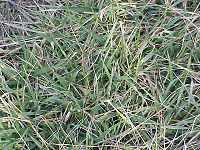
If you were to just look at it, those of you who grew up on a farm or a ranch, would you have any idea what kind of grass this is? It is hard to say in this picture, but I will just tell you. This is fescue.
This is grass hay.
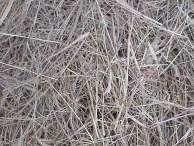
There is some alfalfa or a legume hay.
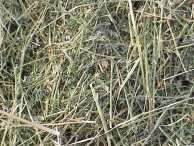
What is the basic difference between grass hay and legume hay? Protein content and calcium content. The grass hay is, generally, cheaper than legume hay. That is true for most parts of the country, except that is not always true in the state of Oregon. The reason is for it is because we grow so much alfalfa here, especially in Eastern Oregon. In Eastern Oregon, you can generally buy a ton of fairly high quality alfalfa for the same price that you would have to pay for high quality grass hay. Examples of grass hay are brome grass, fescue, timothy, bermuda, orchard, rye grass, fox tail. That was a joke. Fox tail is not a good grass hay at all, but we have some at the horse center that we have to try to keep horses from eating. The typical Oregon grasses are timothy, orchard grass, brome grass and we have quite a bit of rye grass up here as well. Legume hay is generally higher in protein and energy and calcium than grass hays. Usually, it costs more because of those things. The examples for legume hay are alfalfa and clover. Most of the legumes we feed in the horse industry is alfalfa. When you select hay, or look at hay, you want to know about its maturity, the texture, the leafiness and it needs to be free of dust, mold, weeds and insects. Specifically, it has to be free of the blister beetle. Has anybody ever heard of the blister beetle before? What does it do to horses? It pretty much kills them. What states have the most problems with blister beetles? Southern states. We do not see the blister beetle very often up here, not even as far south as New Mexico or Colorado, usually not a problem with the blister beetle. We generally do not feed alfalfa that was grown in the state of Texas or Louisiana or Oklahoma to horses. We feed it to dairy cattle; there is no problem at all because microbes in the rumen will totally neutralize that toxin. Microbes in the horse’s cecum would also neutralize them. The only problem is that it is past the site of absorption, so it is already absorbed in the small intestine which is detrimental to the horse before it can be neutralized.
When we look at concentrates, we have oats, corn, barley, those are the
major ones. We also have sorghum. And if you have a sweet feed, the reason
that it is called a sweet feed is because molasses was added to it. Here
you have a straight corn-oat, that maybe has a little bit of barley in
there and there is some soybean meal in there as well. I am going to talk
a little about soybean meal in a minute.
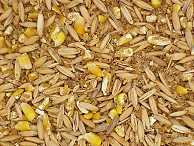
When we talk about adding corn to a horse’s ration, if you look at this corn that is in there, what do you see? It is a cracked a little bit. Like if you look at these particles right here, they’re all cracked. It’s not cracked real well because there is quite a few whole ones in there. What is the problem with feeding whole corn to horses? Unless they really crack down on it with their teeth, and if you have horses that eat a little too fast they just swallow it whole. And the shell of the corn is way too hard for the enzymes to get through and the digestibility goes way, way down. In other words, usually we crack it at the very least. And when it’s cracked, the digestibility goes up to about 65-70%. What process would increase digestibility to 100% in corn? Steam-rolled gets it up to about 80, 75-80%. But you said it, who said that? Popped corn. If you were to pop it and in the horse feed industry that is called micronizing. Why doesn’t anybody do that? It would be kind of pricey. But since the digestibility would be 100% I think it could be dealt with, but there is another big problem with it. It takes up a lot of room. In other words, if a regular size 50-pound bag would weigh about five or six pounds. In other words, a fifty pound bag would be gigantic. It is just not feasible in the horse industry that we micronize the corn. we would not get enough out of it.
What about pellets?
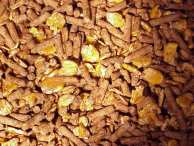
Those of you that have horses, do you like feeding pellets? Some people say they want to totally stay away from feeding pellets. They would much rather feed a mix feed, a grain feed rather than pellets. The thing about pellets is that pellets can be anything. You do not know what they are. It’s hard to just by looking at them, knowing what they are. However, there are some pelletized feeds that are extremely high quality and that you will have to pay for that. But you have to know that, what is in the pellet, in order to make it high quality versus just a filler. Most of the time when you buy a sweet feed that has some amount or some percentage of pellets in there, the cheaper the feed, the more pellets it will have in it, because it is just a fiber filler, like rice hulls or soybean hulls and stuff like that. So that is just a straight filler, straight fiber and sometimes that will be up to 40-50% of the diet, of the grain ration. But if you look at other pellets, that are high quality, for example the feed that we feed out at the horse center is called Strategy, it’s all pellets, but it is a high quality pellet. So in other words you pay for that as well.
Oats are generally high in fiber, or higher in fiber anyways, and have
a lower digestibility than corn, if corn is cracked. If the corn is fed
whole, it has the lowest digestibility of all. They have more protein
quantity as well as quality than corn. What’s the difference between,
you’ll talk about this in other classes as well I’m sure,
what is the difference between quantity and quality of protein? Or I should
say what is quality of protein? Everybody knows what quantity of protein
is. But what is quality of protein? What makes a high quality protein
versus a low quality protein? Have you ever heard of the biological value
of protein or the amino acid profile of protein? The amino acid profile
is what amino acids are in the protein to what amount. And the closer
that amino acid resembles the amino acid profile of muscle tissue, the
higher quality it is, the higher its biological value is. So having said
that, what is the highest quality protein that you could have in your
diet? Red meat, a steak, that would be the highest quality protein. So
if you do not eat that, you have to make it up somehow to get at least
some high quality protein in the horse's diet. Horses do not eat meat.
So what we have to do is we have to find the highest quality proteins
that are a plant source. One of those would be soybean meal, that I am
going to talk about in a little bit. Corn is higher in energy, but lower
in protein than oats. It is easier to overfeed, from a starch overload
standpoint, and all of the problems that are associated with that. But
I will talk more about that in the next class period. Barley, nutritionally,
is right between corn and oats in energy, protein and fiber. And then
sorghum is very similar to corn in energy, protein and fiber. And have
you ever heard of sorghum or milo? It is not as popular here, but it is
often substituted for corn in the Southern states. Whatever is cheaper
is what is being put into the horse ration because it is very similar
nutrition wise. So you want to use whatever costs you less to come up
with an overall better ration, a cheaper ration.
Why would somebody add molasses to a horse diet? Basically, if you add
molasses. What is molasses? It is sugar. So you only can add it to a certain
amount, up to about 6% or 7% percent. People that train race horses, they
always like to have about 12% to 14% in the horse's ration. They want
to feed it, they call it the feed has got to be crawling. What that means
when they pick up a handful of it, it will crawl back down, so it’s
so thick. That is just how race horse people like it. But, it generally
will increase the palatability. Obviously it will reduce the dust. It
is fairly expensive per unit of weight. So, in other words, that will
drive up the price. And it is fairly low in protein. Generally, you do
not want to add something to the ration that is expensive and not high
in protein. Because more often than not is, protein is what you are concerned
about in horses' rations.
Supplement selection. We can have protein supplements such as soybean
meal, canola meal. Calcium and phosphorous which would be dicalcium phosphate
or a limestone. We can add some beta carotene to a horse’s diet
which will turn into vitamin A when it hits the hind gut. And we can add
fats to the horse’s ration to increase energy density of the diet.
What is one of the things here that horses do not have, that people and
other carnivores have, that helps in fat digestion. A gall bladder. And
horses do not have a gall bladder. But they can still digest some fat
because they have some continuous release of bile that comes normally
out of the gall bladder. When you are talking about adding fat to a horse's
ration we are just talking about adding 10% to 12%, at the very most.
If you look at one of our diets, a high fat diet for a human would be
more like 60% fat and we can still digest that pretty much without a problem.
For premixed grains. If you buy a ration from your feed dealer that is
already balanced, it is pretty important that you do not feed it in any
other way than is recommended on the bag. The only thing that you could
do is not feed the amounts recommended, sometimes, because the amounts
that are recommended there are an average amount. So if you have a horse
with a slower metabolism, one is what that we call an easy keeper, you
can feed less of it. But what do not want to do is buy a feed and then
cut it in half with oats because then you throw off the entire balance
of the ration and it is going to end up costing you more in the long run.
So you do not want to do that. If you look up on top at soybean meal,
why would we want to add soybean meal to a horse’s diet? In other
words, what kind of scenario can you think of where there would not be
enough protein in the ration, what kind of ration and for what kind of
horse? Let us say that you do not have access to alfalfa. All you have
is grass hay and all you have is Willamette Valley grass hay, which is
what kind of protein content? About 7% to 10%; 10% if it is fertilized
and 7% if it is not. How much protein would there have to be in the diet
to make up for the protein requirement of the horse? Or how much protein
would there have to be in the grain part of the diet to make up for that
requirement? About 14% to 16%. How do you get there, by feeding corn and
oats? Nope. Because corn only has about 8% or 9%, oats maybe has 11% or
12%. So corn, oats and barley, they do not have any more protein than
that so that would be about 10% or 11% protein. So add some soybean meal,
how much protein is in soybean meal? There is about 45 to 55, depending
on the quality of it. So you add about 10% or 15% of the total ration,
of the total grain, of the soybean meal and you up the entire protein
content by about 15% or 16%. And that takes care of that.
What are complete feeds? What would be a complete feed? There are lots
of different ones. Equine Senior is an example of a complete feed. What
that means is that feed supplies all the nutrients that the horse needs
including the roughage portion. In order to qualify for a complete feed,
from a fiber standpoint, it has to be a minimum of 15% fiber. It if it
is any less than that it is not considered a complete feed, but it will
be considered a concentrate feed. But just because it has 15% or more
percent fiber does not mean it is a complete feed, it is just one of the
requirements. It still has to be balanced for all the other nutrients
as well. What is the problem with feeding a complete feed? The problem
with feeding a complete feed is that your horse will be able to eat all
the requirements, his entire requirements, in probably about 45 minutes
a day. That is a problem. Because for the rest of the time, maybe you
ride him an hour a day or whatever, but for the rest of the time he will
be bored. And when horses are bored, they are going to start cribbing,
they are going to start wood chewing, they are going to develop all kinds
of vices in their stalls. So it really is a good idea to feed them hay,
and feed them a lower quality hay sometimes, so that you have to feed
them more of it and they have to spend several hours eating without getting
fat. Because if you feed them a lot of high quality alfalfa, they will
get fat. They get too much protein and they get too much energy. Even
though they may spend a lot of time eating, the feed is too high quality
and they will get fat on you.
Previous Page | Right click this page to print.